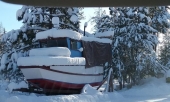
 5
5




Catherine Carney
Rifflerun Farm
 7
7




 2
2




 3
3




Bartholomew Olson wrote:I found an article that explains some more of the how-to, and is a project from my area!
https://crosscut.com/environment/2021/12/swinomish-tribe-wants-resurrect-us-clam-gardening
To create clam gardens, Indigenous communities in the U.S. and Canada historically cleared beaches and moved rocks roughly the size of basketballs to low-tide lines to create walls, or terraces. Over time, the area behind the wall would fill in with sediment and shell hash — broken bits of shells — then flatten out and fill in to create a garden bed.
Just as with a vegetable garden, Hatch says, clam gardens require regular care and demonstrate that people can interact with and harvest from nature in a mutually beneficial way. Tribes maintain the rock terrace as it weathers storms and waves. They remove seaweed, and dig clams strategically, selecting larger clams and making space for smaller ones. If they don’t till the beach, it can get too compact and low in oxygen for baby clams to take root. “People often refer to that as fluffing the beach,” Hatch says.
It’s a time- and energy-intensive responsibility, but one that can connect generations to each other. “It's much, much more than just some rocks in the low tide line, right? It's a really culturally important practice that takes a lot of protocol to activate and maintain,” Hatch said.

Moderator, Treatment Free Beekeepers group on Facebook.
https://www.facebook.com/groups/treatmentfreebeekeepers/





 4
4




Moderator, Treatment Free Beekeepers group on Facebook.
https://www.facebook.com/groups/treatmentfreebeekeepers/





 2
2




Visit Redhawk's soil series: https://permies.com/wiki/redhawk-soil
How permies.com works: https://permies.com/wiki/34193/permies-works-links-threads
 1
1




Invasive plants are Earth's way of insisting we notice her medicines. Stephen Herrod Buhner
Everyone learns what works by learning what doesn't work. Stephen Herrod Buhner

 1
1






How Permies works: https://permies.com/wiki/34193/permies-works-links-threads
My projects on Skye: The tree field, Growing and landracing, perennial polycultures, "Don't dream it - be it! "
 2
2




Moderator, Treatment Free Beekeepers group on Facebook.
https://www.facebook.com/groups/treatmentfreebeekeepers/





 1
1




Marc-Philippe Buckhout from Seas At Risk"Large scale farms might be the industry's preferred way forward," he says, "but we would definitely favour smaller operations that are set in the sort of carrying capacity of the area that they're situated in."
Visit Redhawk's soil series: https://permies.com/wiki/redhawk-soil
How permies.com works: https://permies.com/wiki/34193/permies-works-links-threads
 1
1




Ashley Colby, PhD
Rizomafieldschool.com
https://app.gumroad.com/rizomaschool
















 2
2




How Permies works: https://permies.com/wiki/34193/permies-works-links-threads
My projects on Skye: The tree field, Growing and landracing, perennial polycultures, "Don't dream it - be it! "




So is this just the remnant of one, or is it still being used to harvest fish by someone local?Nancy Reading wrote:It was low tide at the beach today. I never realised before that we had a rock fish trap here....
Visit Redhawk's soil series: https://permies.com/wiki/redhawk-soil
How permies.com works: https://permies.com/wiki/34193/permies-works-links-threads












 2
2




How Permies works: https://permies.com/wiki/34193/permies-works-links-threads
My projects on Skye: The tree field, Growing and landracing, perennial polycultures, "Don't dream it - be it! "

|
Self destruct mode activated. Instructions for deactivation encoded in this tiny ad.
The new kickstarter is now live!
https://www.kickstarter.com/projects/paulwheaton/garden-cards
|







